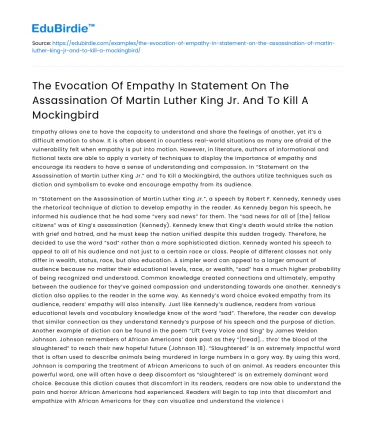Empathy allows one to have the capacity to understand and share the feelings of another, yet it’s a difficult emotion to show. It is often absent in countless real-world situations as many are afraid of the vulnerability felt when empathy is put into motion. However, in literature, authors of informational and fictional texts are able to apply a variety of techniques to display the importance of empathy and encourage its readers to have a sense of understanding and compassion. In “Statement on the Assassination of Martin Luther King Jr.” and To Kill a Mockingbird, the authors utilize techniques such as diction and symbolism to evoke and encourage empathy from its audience.
In “Statement on the Assassination of Martin Luther King Jr.”, a speech by Robert F. Kennedy, Kennedy uses the rhetorical technique of diction to develop empathy in the reader. As Kennedy began his speech, he informed his audience that he had some “very sad news” for them. The “sad news for all of [the] fellow citizens” was of King’s assassination (Kennedy). Kennedy knew that King’s death would strike the nation with grief and hatred, and he must keep the nation unified despite this sudden tragedy. Therefore, he decided to use the word “sad” rather than a more sophisticated diction. Kennedy wanted his speech to appeal to all of his audience and not just to a certain race or class. People of different classes not only differ in wealth, status, race, but also education. A simpler word can appeal to a larger amount of audience because no matter their educational levels, race, or wealth, “sad” has a much higher probability of being recognized and understood. Common knowledge created connections and ultimately, empathy between the audience for they’ve gained compassion and understanding towards one another. Kennedy’s diction also applies to the reader in the same way. As Kennedy’s word choice evoked empathy from its audience, readers’ empathy will also intensify. Just like Kennedy’s audience, readers from various educational levels and vocabulary knowledge know of the word “sad”. Therefore, the reader can develop that similar connection as they understand Kennedy’s purpose of his speech and the purpose of diction. Another example of diction can be found in the poem “Lift Every Voice and Sing” by James Weldon Johnson. Johnson remembers of African Americans’ dark past as they “[tread]... thro’ the blood of the slaughtered” to reach their new hopeful future (Johnson 18). “Slaughtered” is an extremely impactful word that is often used to describe animals being murdered in large numbers in a gory way. By using this word, Johnson is comparing the treatment of African Americans to such of an animal. As readers encounter this powerful word, one will often have a deep discomfort as “slaughtered” is an extremely dominant word choice. Because this diction causes that discomfort in its readers, readers are now able to understand the pain and horror African Americans had experienced. Readers will begin to tap into that discomfort and empathize with African Americans for they can visualize and understand the violence inflicted upon the blacks and how much they’ve endured to reach the buoyant future. The authors’ choice of words greatly impacts the reader’s ability to develop empathy.
Save your time!
We can take care of your essay
- Proper editing and formatting
- Free revision, title page, and bibliography
- Flexible prices and money-back guarantee
In Harper Lee’s novel, To Kill a Mockingbird, another technique is used: the literary device, symbolism. Lee uses the symbolism of a mockingbird. In the novel, it was “a sin to kill a mockingbird” for mockingbirds “don’t do one thing but make music for us to enjoy” (Lee 119). A mockingbird does not “eat up people’s garden” nor do they “nest in corncribs” (119). The mockingbird symbolizes innocence and beauty, and killing one would be considered as an act of cruelty. With this symbolism, readers can recognize each of the mockingbirds in Lee’s novel. These mockingbirds, like Tom Robinson, were forced by Maycomb to experience unfortunate events and ultimately a tragic end even though they were innocent and had done nothing but kind acts. Readers understand the unfairness and brutality as Maycomb blindly kills multiple mockingbirds in its town. Therefore, readers could empathize with those mockingbirds as they understand their suffering and injustice for they were wrongfully killed when they were nothing but an innocent soul. The use of symbolism is also present in Eugenia Collier’s short story, “Marigolds”. The young narrator, Lizabeth, found the marigolds belonging to her town’s outcast, Miss Lottie, frustrating for it was too beautiful in her dusty town. Therefore, Lizabeth destroyed Miss Lottie’s marigolds. However, the marigolds were not just simple flowers in Miss Lottie’s front porch; they represented the hope and happiness Miss Lottie desperately wanted to cherish despite her circumstances. She had “dared to create beauty in the midst of ugliness” and the “love and beauty and joy that had not been squeezed out by life, had been there in the marigolds she had so tenderly cared for” (Collier 62). Readers now understand that Miss Lottie was not the eccentric neighbor of Lizabeth who was considered odd for growing such beautiful things; she was simply a woman who had the courage to hold onto her hope and happiness despite her situation. Readers have now gained compassion and empathy for Miss Lottie and her destroyed marigolds, and along with it, her hopes and happiness.
The authors from “Statement on the Assassination of Martin Luther King Jr.” and To Kill a Mockingbird used a variety of rhetorical techniques and literary devices to induce empathy in its readers. Strong and appropriate diction allows the author to get their message of empathy across. Symbolism relates a universal topic, such as empathy, to a deeper symbolic meaning and give readers a better insight into the author’s message. With these techniques, readers are able to understand the author’s and even the characters’ intentions, and eventually will gradually develop empathy.






 Stuck on your essay?
Stuck on your essay?

